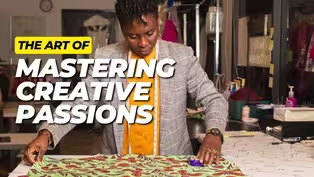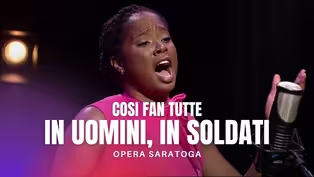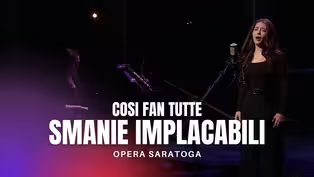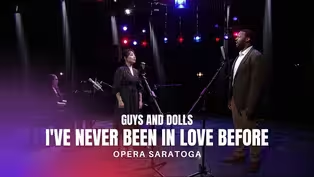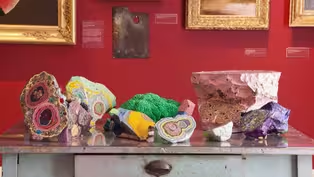
Mo Rabiu's Impact on the World of Modern Tailoring
Clip: Season 9 Episode 24 | 6m 24sVideo has Closed Captions
Mo discusses his inspiring journey from finance to sustainable fashion design.
Meet Mo Rabiu, who swapped her finance career for fashion, purchasing European Tailoring in Albany, NY. Discover her inspiring journey from crunching numbers to creating bespoke suits and wedding dresses, all while championing sustainability through her brand So Radical.
Problems playing video? | Closed Captioning Feedback
Problems playing video? | Closed Captioning Feedback
AHA! A House for Arts is a local public television program presented by WMHT
Support provided by the New York State Council on the Arts (NYSCA), M&T Bank, the Leo Cox Beach Philanthropic Foundation, and is also provided by contributors to the WMHT Venture...

Mo Rabiu's Impact on the World of Modern Tailoring
Clip: Season 9 Episode 24 | 6m 24sVideo has Closed Captions
Meet Mo Rabiu, who swapped her finance career for fashion, purchasing European Tailoring in Albany, NY. Discover her inspiring journey from crunching numbers to creating bespoke suits and wedding dresses, all while championing sustainability through her brand So Radical.
Problems playing video? | Closed Captioning Feedback
How to Watch AHA! A House for Arts
AHA! A House for Arts is available to stream on pbs.org and the free PBS App, available on iPhone, Apple TV, Android TV, Android smartphones, Amazon Fire TV, Amazon Fire Tablet, Roku, Samsung Smart TV, and Vizio.
Providing Support for PBS.org
Learn Moreabout PBS online sponsorshipI am really inspired by my roots and heritage in, of African culture.
So seeing a lot of like textiles and fabric as my own mom was a, you know, fabric designer herself.
So I was like born into it.
- Yeah.
- But it was never like really visible to do and to, you know, to sustain a lifestyle.
Coming from Africa, your parents want you to, you know, have an education, stability, and have, you know, an income, a steady income.
So it was like, okay, you go to school and I went to school.
I got an accounting degree.
I worked in finance for a very long time.
Yes, and say 2020 came and I made a move to really creating my own brand and European Tailoring became available.
I just said, you know what, this is a great opportunity for me to really dive into what I love, to really express my creativity.
So that was what, you know, inspired European Tailoring.
- So like, give us a little bit of background.
What is European Tailoring?
- The actual service is just tailoring.
I do make suits and wedding dresses.
I mend clothes.
So it's just all around anything that has to do with textile.
- And tailoring is something that is so important today because we feel like we, you don't really see it as much anymore in my personal opinion.
You can let me know.
Is it like a dying craft?
- Absolutely, absolutely.
It is a dying craft.
Not a lot of young people are into it.
And I would say even in our area in this community, I'm one of the youngest people in this trade.
So it is quite interesting.
But I love it and I encourage people during my downtime, my down season, I tend to teach people, but it is, it's something that I want more and more people to get into 'cause it really helps with sustainability.
- It really does.
And speaking of, let's talk about your fashion brand So Radical.
So what is it and what is its mission?
- So Radical is a fashion brand that really intend on sustainability.
And it is about making sure that creating pieces, timeless pieces, that we can enjoy for a very long time.
And that was the mission, that was the statement mission from the get go of creating So Radical is, you know, coming from that tailoring background and you know, getting a lot of fabric.
And I usually, I just throw them out or I take it to Goodwill and I go, you know, I can really create something with this.
And that's how it started.
It was just taking, you know, modern fabrics and vintage fabric and mixing it together to create streetwear and avant garde pieces.
- Awesome, and would you say like the style is avant garde, or what would be the style of your pieces?
- The style is, you know, it's in the name.
It's so radical, like it's never a one way street.
So I go, I can go from like designing a couture to a T-shirt to, you know, it's all over the place.
So we are not following a template.
So it is so radical what we make.
- Oh, I love it.
So how do you convince people that slow fashion or we worked or upcycled, there's so many terms that go with this, is the way to go because you know, this is a sustainable practice.
You're reworking vintage or reused clothing or unused clothing, but where does it have to go?
- [Mo] Right.
- And you're creating art pieces from it.
So how do you convince people that this is the most sustainable, ethical way to buy clothing?
- That's a great question.
I usually try to emphasize on quality over quantity.
And one of the things is that, you know, being able to tell a story through a piece.
Every time, you know, a customer comes into the studio is that, you know this was made from a blanket?
And they go what?
It's like yep.
And you know, the ability to tell stories and also educating clients and customers about, you know, our carbon footprint and fast fashion has done a great deal of damaging our climate change, our climate.
So I'm just trying to create a little change that I can by starting So Radical and also educating people about sustainability.
And let's buy slow, you know, you can buy from anywhere.
You get a lot of stuff for like a hundred dollars, right?
But then you get two washes out of it and it's like, uh-oh, now I gotta go back again.
But so creating, buying slow means a piece might be a little bit expensive, but then you wear it more and you have that one of one piece that, you know, something that nobody else have, so you can really enjoy, you know, that piece and really, you know, tell the story that comes with that.
- One question before we wrap up is collaboration.
Do you collaborate with folks?
- On my design, no.
But as far as like when we have things like I've collaborated with like DJs and I've collaborated with all the people in the community, but yeah, I do love to collaborate because I think it's very important to our community.
It is, we need to tell stories when we do these things, we tell each other's stories and we create cultural awareness in the area that it, though it is a small space, but we can tell our own story and create our own vibe, so to speak.
So I think it is very important.
- Right, thank you so much Mo, for talking about So Radical and European Tailoring and all the great work that you're doing.
- Thank you so much for having me.
This is a great pleasure.
The Art of Mastering Creative Passions: Preview
Video has Closed Captions
Preview: S9 Ep24 | 30s | Explore beeswax art, fashion tailoring, and opera in this episode of "AHA, A House for Arts." (30s)
Opera Saratoga Performs Cosi Fan Tutte "In Uomini, In Soldati"
Video has Closed Captions
Clip: S9 Ep24 | 2m 33s | Watch Opera Saratoga perform excerpts from their current season. (2m 33s)
Opera Saratoga Performs Cosi Fan Tutte "Smanie Implacabili"
Video has Closed Captions
Clip: S9 Ep24 | 3m 10s | Watch Opera Saratoga perform excerpts from their current season. (3m 10s)
Opera Saratoga Performs Guys And Dolls "I've Never Been In Love Before"
Video has Closed Captions
Clip: S9 Ep24 | 4m 1s | Watch Opera Saratoga perform excerpts from their current season. (4m 1s)
Video has Closed Captions
Clip: S9 Ep24 | 7m 57s | Explore Laura Moriarty's art made with pigmented beeswax in Rosendale, NY. (7m 57s)
Providing Support for PBS.org
Learn Moreabout PBS online sponsorshipSupport for PBS provided by:
AHA! A House for Arts is a local public television program presented by WMHT
Support provided by the New York State Council on the Arts (NYSCA), M&T Bank, the Leo Cox Beach Philanthropic Foundation, and is also provided by contributors to the WMHT Venture...
